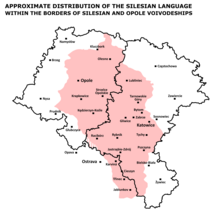
Back Silesies Afrikaans Schlesisch (Slawisch) ALS ሳይሌሲያን Amharic Silesisc gereord ANG اللغة السيليزية Arabic سيليسى ARZ Idioma silesiu AST Силез теле Bashkir Sėlezu kalba BAT-SMG Сілезскі этналект Byelorussian
| Silesian | |
|---|---|
| Upper Silesian | |
| ślōnskŏ gŏdka ślůnsko godka[1] | |
| Pronunciation | [ˈɕlonskɔ ˈɡɔtka] |
| Native to | Poland (Silesian Voivodeship, Opole Voivodeship) Czech Republic (Moravia–Silesia, Jeseník) |
| Region | Silesia |
| Ethnicity | Silesians |
Native speakers | 457,900 (2021 census)[2] |
| Dialects | |
| Latin script (Steuer's alphabet and ślabikŏrzowy szrajbōnek)[3] | |
| Language codes | |
| ISO 639-3 | szl |
| Glottolog | sile1253 |
| ELP | Upper Silesian |
| Linguasphere | |


Silesian,[a] occasionally called Upper Silesian, is an ethnolect[4][5] of the Lechitic group spoken by part of people in Upper Silesia. Its vocabulary was significantly influenced by Central German due to the existence of numerous Silesian German speakers in the area prior to World War II and after.[6] The first mentions of Silesian as a distinct lect date back to the 16th century, and the first literature with Silesian characteristics to the 17th century.[7]
Linguistic distinctiveness of Silesian has long been a topic of discussion among linguists.[8] Some regard it as one of the four major dialects of Polish,[9][10][11][12] while others classify it as a separate regional language, distinct from Polish.[13][14][15] According to the official data from the 2021 Polish census, about 500 thousand people consider Silesian as their native language.[2]
In April 2024, the Polish Sejm took a significant step by approving a bill that recognizes Silesian as an official regional language in Poland.[8] This recognition, if accepted by the Senate and signed by the president, will allow for the inclusion of Silesian in school curricula and its use within local administration in municipalities.[8]
- ^ a b "Ethnologue report for language code:
szl". Ethnologue. Languages of the World. - ^ a b "Wstępne wyniki Narodowego Spisu Powszechnego Ludności i Mieszkań 2021 w zakresie struktury narodowo-etnicznej oraz języka kontaktów domowych" [Report of results: National Census of Population and Housing, 2021.] (PDF). Central Statistical Office of Poland (in Polish). 2023.
- ^ Silesian language at Ethnologue (21st ed., 2018)

- ^ Ptak, Alicja (28 December 2022). "Supermarket introduces bilingual Polish-Silesian signs". Kraków: Notes from Poland. Retrieved 14 April 2023.
- ^ Tilles, Daniel (13 April 2023). "New census data reveal changes in Poland's ethnic and linguistic makeup". Kraków: Notes from Poland. Retrieved 14 April 2023.
- ^ Tomasz Kamusella. 2013. The Silesian Language in the Early 21st Century: A Speech Community on the Rollercoaster of Politics (pp 1–35). Die Welt der Slaven. Vol 58, No 1.
- ^ "Najstarszy zabytek śląskiej literatury? (Część 1)". Wachtyrz.eu (in Polish). 18 August 2020. Retrieved 21 June 2023.
Najstarsze dokumenty będące świadectwem wyodrębniania się dialektów śląskich w oddzielną grupę pochodzą z XVI w. Należą do nich m. in. list Ambrożego Szklorza z Olesna opublikowany przez Władysława Nehringa (Nehring 1902 [1]) i rachunek ślusarza Matysa Hady opublikowany przez Leona Derlicha i Andrzeja Siuduta (Derlich, Siudut 1957). Są to jednak zabytki piśmiennictwa, a nie literatury – początków tej drugiej można się doszukiwać na Śląsku w najlepszym razie dopiero w wieku XVII.
- ^ a b c Tilles, Daniel (26 April 2024). "Law to recognise Silesian as regional language in Poland approved by parliament". Kraków: Notes from Poland. Retrieved 29 April 2024.
- ^ Gwara Śląska – świadectwo kultury, narzędzie komunikacji. Jolanta Tambor (eds.); Aldona Skudrzykowa. Katowice: „Śląsk". 2002. ISBN 83-7164-314-4. OCLC 830518005.
{{cite book}}: CS1 maint: others (link) - ^ „Słownik gwar Śląskich". Opole, Bogusław Wyderka (eds.)
- ^ „Dialekt śląski" author: Feliks Pluta, publication: Wczoraj, Dzisiaj, Jutro. – 1996, no 1/4, pp 5–19
- ^ „Fenomen śląskiej gwary" author: Jan Miodek publication: Śląsk. – 1996, no 5, pp 52
- ^ Ptak, Alicja (28 December 2022). "Supermarket introduces bilingual Polish-Silesian signs". Kraków: Notes from Poland. Retrieved 14 April 2023.
- ^ Norman Davies, Europe: A History, Oxford 1996 pp 1233
- ^ Jolanta Tambor. Opinia merytoryczna na temat poselskiego projektu ustawy o zmianie Ustawy o mniejszościach narodowych i etnicznych oraz o języku regionalnym, a także niektórych innych ustaw, Warszawa 3 maja 2011 r. (English: Substantive opinion on the parliamentary bill amending the Act on national and ethnic minorities and on the regional language, as well as some other acts, Warsaw, May 3, 2011.)
Cite error: There are <ref group=lower-alpha> tags or {{efn}} templates on this page, but the references will not show without a {{reflist|group=lower-alpha}} template or {{notelist}} template (see the help page).
© MMXXIII Rich X Search. We shall prevail. All rights reserved. Rich X Search